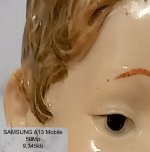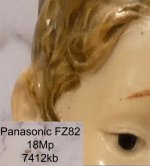- Messages
- 6
- Name
- Terence Foster
- Edit My Images
- Yes
Hi everyone my name is Terry and I am from Hull. (UK)
I have several questions but I'll try and keep this as a starter topic regarding noise on photographs.
I have had a discussion on FB regarding Mobile cameras versus Bridge and SLR, and people tell me SLR is the way to go.
I take pictures for reference in my art.
I have three cameras.
1. Canon E550d with main lens 18-200 but this is heavy and restricts my zoom to 200.
Pros it can process RAW but it is only 18mp
2. Panasonic FZ82 20-1200 zoom with 18mp again.
Pros - lightweight with great 64x zoom.
Cons - cannot edit Raw RW2 files on Windows 7 or 10.
3. Phone camera Samsung A13 with 50mp camera - always on hand.
Pros - clearer image with less noise
cons - point and shoot!
I had a discussion on fb with people saying my phone is inferior - however I proved otherwise with some sample photos and close ups.
The problem I have with the bridge and SLR is that the image has a lot of noise and I wondered why Panasonic had not at least considered upgrading its sensor to 50mp since its agvailable on phones!
I want to know how I can reduce noise on my camera images.
Id really love to improve on the panasonic FZ82 as it's features are amazing for the price.
I would not mind paying a bit more for an upgraded version but there has been no extension of the FZ82 for 3 years now to my knowledge.
I would attach images but it would appear I am unable to select and upload any at this moment.
Thanks in advance for any feedback.
Terry
I have several questions but I'll try and keep this as a starter topic regarding noise on photographs.
I have had a discussion on FB regarding Mobile cameras versus Bridge and SLR, and people tell me SLR is the way to go.
I take pictures for reference in my art.
I have three cameras.
1. Canon E550d with main lens 18-200 but this is heavy and restricts my zoom to 200.
Pros it can process RAW but it is only 18mp
2. Panasonic FZ82 20-1200 zoom with 18mp again.
Pros - lightweight with great 64x zoom.
Cons - cannot edit Raw RW2 files on Windows 7 or 10.
3. Phone camera Samsung A13 with 50mp camera - always on hand.
Pros - clearer image with less noise
cons - point and shoot!
I had a discussion on fb with people saying my phone is inferior - however I proved otherwise with some sample photos and close ups.
The problem I have with the bridge and SLR is that the image has a lot of noise and I wondered why Panasonic had not at least considered upgrading its sensor to 50mp since its agvailable on phones!
I want to know how I can reduce noise on my camera images.
Id really love to improve on the panasonic FZ82 as it's features are amazing for the price.
I would not mind paying a bit more for an upgraded version but there has been no extension of the FZ82 for 3 years now to my knowledge.
I would attach images but it would appear I am unable to select and upload any at this moment.
Thanks in advance for any feedback.
Terry
Last edited:




